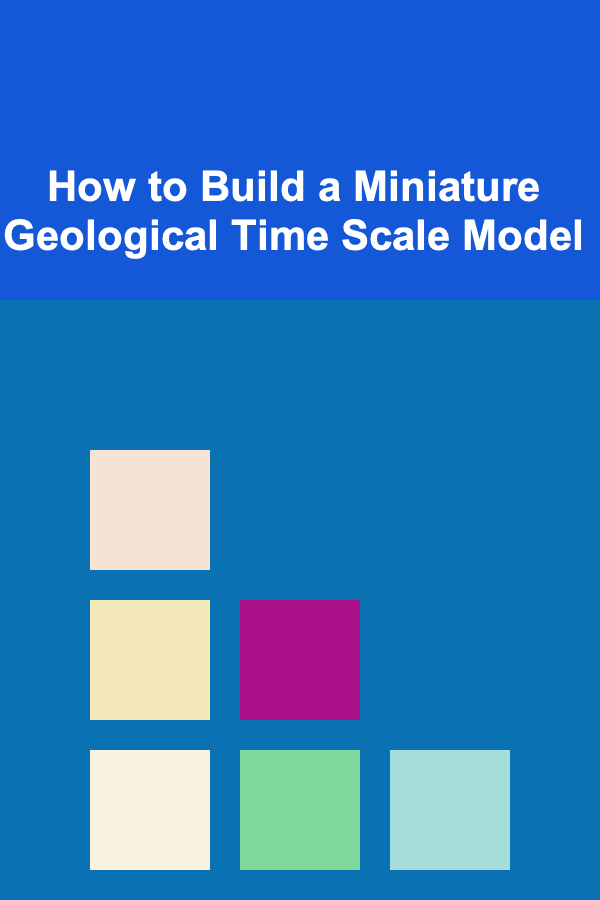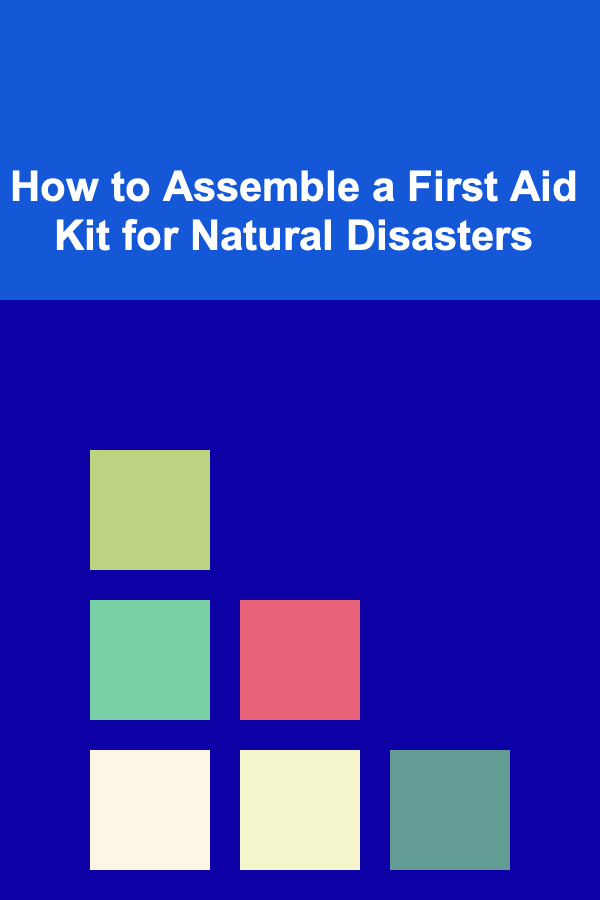
How to Build a Miniature Geological Time Scale Model
ebook include PDF & Audio bundle (Micro Guide)
$12.99$8.99
Limited Time Offer! Order within the next:

The geological time scale (GTS) is one of the most important concepts in understanding Earth's history. It is a system used by geologists to describe the timing and relationships of events in Earth's past, spanning over 4.5 billion years of existence. Constructing a miniature geological time scale model offers an excellent hands-on way to visualize the vastness of time, from the formation of the Earth to the present day, and provides a concrete way to understand the relative duration of geological eras, periods, and epochs.
In this guide, we'll take you step by step through the process of creating your very own miniature geological time scale model. We'll explore the significance of each geological era and period, the materials you'll need, and how to assemble and scale the model. Whether you're a student, educator, or enthusiast looking to grasp the concept of geological time, building this model is an educational and engaging project.
Materials You Will Need
To create your miniature geological time scale model, you'll need several materials to represent the different geological periods and epochs. These materials will help you construct the physical model, along with a few basic tools for precision and customization. Here's a list of materials and tools that will be helpful:
Materials
- Colored Clay or Play-Doh: Different colors will represent different eras and periods.
- Wooden or Foam Base: A sturdy base to attach and arrange your timeline.
- Paint or Markers: To color-code and label the model.
- Measuring Tape or Ruler: For accurate scaling and measurements.
- Scissors: For cutting clay or other materials.
- Small Labels or Tags: To mark different periods, epochs, or eras.
- Clear Plastic Sheets or Resin: To add a transparent layer to the top of your model, preserving the integrity of the timeline.
- Hot Glue Gun: To attach clay or labels to the base securely.
- Reference Sheet for Geological Time Scale: A printed geological time scale for accurate information about each period, epoch, and era.
Tools
- Brushes: For painting or applying fine details.
- Knife: For fine cutting, shaping, and trimming of the clay or foam.
- Caliper or Precision Ruler: For precise measurements when scaling down the time.
Step-by-Step Guide to Building a Miniature Geological Time Scale Model
Step 1: Understanding the Geological Time Scale
Before diving into the construction process, it's important to have a solid understanding of the geological time scale. The GTS is typically divided into several major divisions:
-
Eons: The largest division of geological time, each eon spans hundreds of millions to billions of years.
- Hadean Eon (4.6 to 4.0 billion years ago)
- Archean Eon (4.0 to 2.5 billion years ago)
- Proterozoic Eon (2.5 billion to 541 million years ago)
- Phanerozoic Eon (541 million years ago to present day)
-
Eras: Each eon is divided into eras, which represent major events in Earth's history.
- Paleozoic Era (541 to 252 million years ago)
- Mesozoic Era (252 to 66 million years ago)
- Cenozoic Era (66 million years ago to present)
-
Periods: Eras are further divided into periods, representing significant geological and biological events.
- For example, the Paleozoic Era includes periods like the Cambrian, Ordovician, and Silurian, while the Mesozoic Era includes the Triassic, Jurassic, and Cretaceous periods.
-
Epochs: Periods can be further divided into epochs, which represent shorter intervals of geological time.
The goal is to represent these divisions in a compact, visually appealing format. The scale of time is vast, so you will need to create a model that fits within a manageable size while maintaining the relative proportions between the different periods.
Step 2: Scale the Geological Time
Since the geological time scale spans billions of years, creating a miniature model requires scaling down the vastness of time. To make this manageable, we will represent a significant chunk of Earth's history on a single model, using relative measurements.
For example:
- The entire Earth's history (4.6 billion years) could be represented as the length of your model (say, 1 meter). In that case, 1 millimeter could represent 4.6 million years.
- The Phanerozoic Eon (541 million years) would span a much smaller section of your model (e.g., 11.8 cm if you are using the 1mm = 4.6 million years scale).
Using this scale, you can calculate the length of each section for different periods and eras by dividing their durations by the overall model length. The result is a proportional representation of time, where the model visually reflects the relative lengths of each geological division.
Step 3: Preparing the Base
Once you've chosen your scale and measured the appropriate lengths, it's time to prepare the base of the model. A wooden or foam board is ideal for this project because it is sturdy and lightweight.
- Mark the Starting Point: Use a ruler or measuring tape to mark the beginning of your timeline. This will be the start of Earth's formation (the Hadean Eon).
- Draw a Straight Line: With a pencil, draw a long, straight line across the length of your base. This line will represent the timeline.
- Divide the Line: Based on your calculations, divide the line into sections for each eon, era, and period. Use a ruler to measure the appropriate lengths.
Step 4: Creating the Geological Time Scale with Colored Clay
Colored clay or Play-Doh is an excellent material for building up the sections of your time scale. Each color will represent a different geological division, making the model both visually appealing and informative.
-
Roll the Clay: Roll out small sections of colored clay to match the lengths of each time period on your model. For example:
- Hadean Eon (4.6 billion years ago): Use dark colors like black or dark brown to represent this period, as Earth was still a molten mass during this time.
- Archean Eon (4.0 to 2.5 billion years ago): Use brown or gray tones to represent the formation of the Earth's crust.
- Proterozoic Eon (2.5 billion to 541 million years ago): You could use shades of green or blue to represent the emergence of life and the development of early oceans.
- Phanerozoic Eon (541 million years ago to present): Use lighter colors, like blue or green, to indicate the evolution of complex life forms.
-
Attach the Clay: Carefully place the clay strips onto your base, following the divisions you've marked. Use your fingers or a tool to smooth and shape the clay into even sections. Ensure the clay is securely attached to the base using a hot glue gun if necessary.
-
Label Each Section: For clarity, label each section of your model with a small tag or piece of paper. Use a fine-tip marker or paint to write the name of each era, period, or epoch. Position the labels next to the corresponding sections of clay.
Step 5: Adding Details to the Model
Once the basic timeline is constructed, it's time to add some finishing touches.
- Add Layered Effects: You can layer different colors of clay to represent specific events in geological history. For example, in the Mesozoic Era, you can use a mix of colors to represent the mass extinction event at the end of the Cretaceous Period.
- Create a 3D Effect: Use small pieces of clay or resin to add a 3D effect to the model. This can represent major geological events like volcanic eruptions or the formation of mountain ranges.
- Transparent Layer: To preserve your model and give it a polished look, you can cover the entire time scale with a layer of clear plastic or resin. This will protect the clay sections while giving the model a clean finish.
Step 6: Displaying and Using Your Model
Once your model is complete, it's time to display it. This model can be used as an educational tool, helping others understand the vastness of geological time and the sequence of events that have shaped Earth's history.
You can also make your model interactive by:
- Adding Timeline Markers: Use a color-coded system for major geological events such as the appearance of life, the mass extinctions, or the formation of continents.
- Creating a Key: Include a legend or key to explain the different colors, making it easy for others to understand your model.
Conclusion
Building a miniature geological time scale model is not only a fun and creative project but also an invaluable educational tool. Through this model, you'll gain a deeper appreciation for the immense span of time that Earth has experienced. By using this hands-on approach, you can better grasp the concept of geological time and how different events in Earth's history are interconnected. Whether you're a student, teacher, or just a geology enthusiast, this model will serve as a great reminder of the history of our planet and the forces that have shaped it over billions of years.
Reading More From Our Other Websites
- [Home Rental Property 101] How to Decorate and Personalize Furnished Apartments for Rent Without Damaging the Property
- [Home Staging 101] How to Light Up Your Underground: Illumination Strategies for Successful Staging a Basement
- [Home Lighting 101] How to Create Inviting Outdoor Spaces with Strategic Deck Lighting
- [Home Staging 101] How to Create a Comprehensive Guide to Home Staging Resources
- [Personal Care Tips 101] How to Incorporate a Facial Cleanser Into Your Nighttime Skincare Routine
- [Personal Investment 101] How to Save Money Effectively: The Best Ways to Build Wealth
- [Home Rental Property 101] How to Choose the Best Location for Your Rental Property Investment
- [Home Space Saving 101] How to Maximize Your Entryway for a Clutter-Free Home
- [Organization Tip 101] How to Use Baskets and Bins to Tidy Up Your Fitness Area
- [Organization Tip 101] Affordable Industrial Style Lighting Fixtures for Budget-Friendly Home Improvements

How to Plan for Financial Success as a Millennial
Read More
How to Sell Your Antique Coins on eBay: A Comprehensive Guide
Read More
How to Set Up Payment Gateways in Shopify for Seamless Transactions
Read More
How to Track Your Expenses Without Getting Overwhelmed
Read More
Why Organizing Seasonal Decorations Makes Holidays Brighter
Read More
How to Assemble a First Aid Kit for Natural Disasters
Read MoreOther Products

How to Plan for Financial Success as a Millennial
Read More
How to Sell Your Antique Coins on eBay: A Comprehensive Guide
Read More
How to Set Up Payment Gateways in Shopify for Seamless Transactions
Read More
How to Track Your Expenses Without Getting Overwhelmed
Read More
Why Organizing Seasonal Decorations Makes Holidays Brighter
Read More